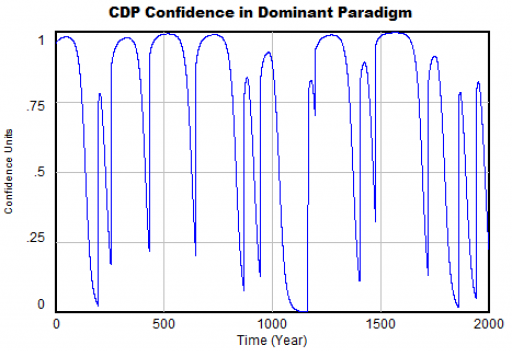It’s all in this one picture, by M. Granger Morgan, Milind Kandlikar, James Risbey & Hadi Dowlatabadi:

If you’re interested in modeling the opioid epidemic, this New Yorker article is a must-read:
The Family That Built an Empire of Pain
The Sackler dynasty’s ruthless marketing of painkillers has generated billions of dollars—and millions of addicts.
Most systems thinkers are familiar with the parable of the blind men and the elephant.
Composer Kenji Bunch has set it to music:
Today I was looking for DYNAMO documentation of the TRND macro. Lo and behold, archive.org has the second edition of the DYNAMO User Guide online. It reminds me that I was lucky to have missed the punch card era:
… but not quite lucky enough to miss timesharing and the teletype:
The computer under my desk today would have been the fastest in the world the year I finished my dissertation. We’ve come a long way.
E, a.k.a. Euler’s number or the base of the natural logarithm, is near and dear to dynamic modelers. It’s not just the root of exponential growth and decay; thanks to Euler’s Formula it encompasses oscillation, and therefore all things dynamic.
E is approximately 2.718, and today is 2/7/18, at least to Americans, so this is the biggest e day for a while. (NASA has the next 1,999,996 digits, should you need them.) Unlike π, e has not been contested in any state legislature that I know of.
VisualCapitalist has a cool comprehensive map of cognitive biases:
(Click through for the big version.)
The (more or less) corresponding wiki list is here.
It’s a wonder that we ever get anything right!
PsyBlog has some thoughts on antidotes.
h/t Dr MJ
For the 2017 Balaton Group meeting, I’ve updated Sterman & Wittenberg’s Path Dependence, Competition, and Succession in the Dynamics of Scientific Revolution model. The new version is far more usable, with readable variable names and improved diagrams.

This is an extremely interesting model for our current situation of clashing paradigms, fake news and filter bubbles. I encourage you to take a look at the model and paper.
This is actually much more natural as a Ventity model, so watch for another update.
In the near future I’ll be running an experiment with serving advertisements on this site, starting with Google AdSense.
This is motivated by a little bit of greed (to defray the costs of hosting) and a lot of curiosity.
I’m generally wary of running society’s information system on a paid basis. (Recall the first deadly sin of complex system management.) On the other hand, there are certainly valid interests in sharing commercial information.
I plan to write about the outcome down the road, but first I’d like to get some firsthand experience.
What do you think?
Update: The experiment is over.
Here’s a nice example of how AI is killing us now. I won’t dignify this with a link, but I found it posted by a LinkedIn user.
I’d call this an example of artificial stupidity, not AI. The article starts off sounding plausible, but quickly degenerates into complete nonsense that’s either automatically generated or translated, with catastrophic results. But it was good enough to make it past someone’s cognitive filters.

For years, corporations have targeted on World Health Organization to indicate ads to and once to indicate the ads. AI permits marketers to, instead, specialize in what messages to indicate the audience, therefore, brands will produce powerful ads specific to the target market. With programmatic accounting for 67% of all international show ads in 2017, AI is required quite ever to make sure the inflated volume of ads doesn’t have an effect on the standard of ads.
One style of AI that’s showing important promise during this space is tongue process (NLP). informatics could be a psychological feature machine learning technology which will realize trends in behavior and traffic an equivalent method an individual’s brain will. mistreatment informatics during this method can match ads with people supported context, compared to only keywords within the past, thus considerably increasing click rates and conversions.